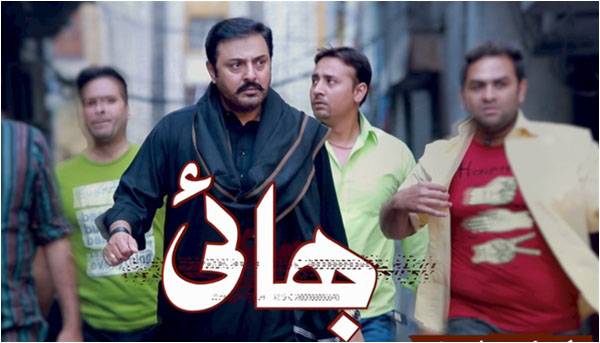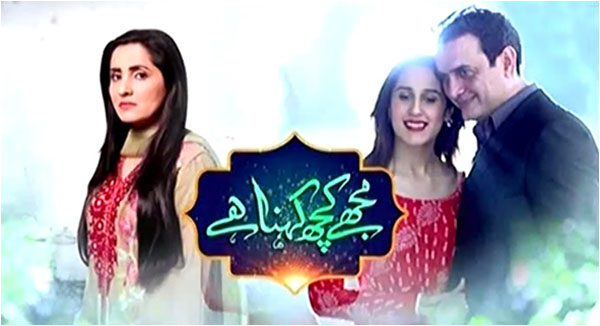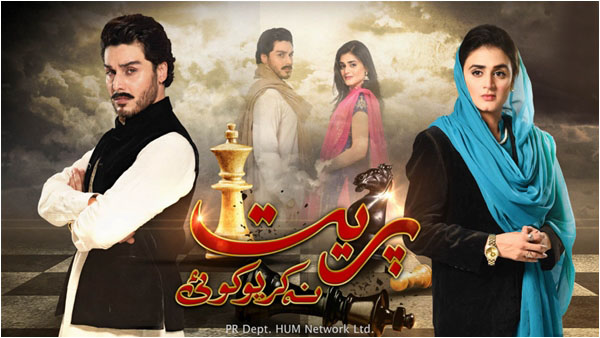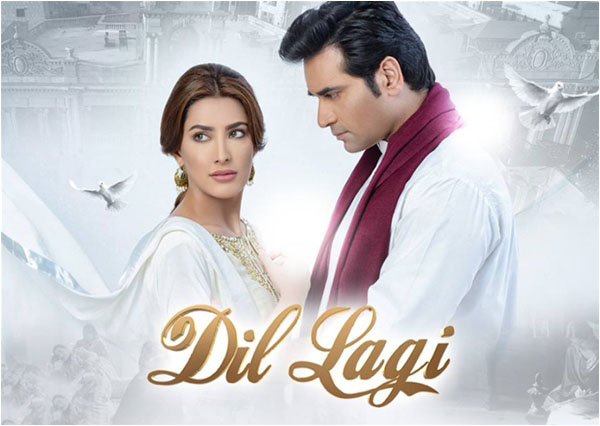
Just a few months ago, when I sat down to gather my thoughts for a year-end overview of TV dramas I’d wondered if this would be the last time I would be writing such a post. Through the years I have seen many ebbs and flows in the quality of content, but even in the worst of times there were always some noteworthy exceptions. But what we saw in 2015, in terms of quality, was probably the worst output I have seen from our drama industry. Crass commercialism overrode considerations of artistic integrity, and social responsibility barely registered as a blip on the radar - it was all about getting ratings no matter what the cost.
When 2016 began I had little or no expectations from our money-minded drama industrialists. Three months in, however, it seems like perhaps all is not lost yet. Though commercial concerns still rule supreme and familiar themes - multiple marriages, easy divorces, weak women, endless tears, domestic abuse - are very much present and continue to be considered bankable, there seems to be an effort to come up with something different. The extent to which these ‘hat ke” projects succeed in going against the standard narrative is arguable but there is definitely a sense of change.

Take for instance Bhai. In times when an overwhelming majority of our serials feature female-centric stories, this serial offers an interesting alternative in that it revolves around a male protagonist. Set in inner-city Lahore, the aptly titled Bhai is the story of a local councilor Ashraf, who is not only bhai to his four younger siblings, but is also the de facto bhai of the neighborhood, complete with a retinue of small-time goons who look up to him as their leader.
Ashraf is the oldest son of Munir and Shakila, and he takes over the family affairs after Munir suffers a stroke. With Munir paralysed there is no stopping Ashraf as he expands his ‘business’ by invoking terror and employing underhanded means. Shakila has little or no say in household matters, and can only stand by in despair as her older son wreaks havoc not just outside the house, but also on the inside. Things come to a head when Ashraf and his younger brother Hammad fall in love with the same girl, Ifra, thus inverting a much hackneyed trope: two sisters falling for the same guy.

In the recent past there have been numerous serials featuring sisters’ rivalry - Maat, Madiha Maliha, Aks, Mirat-ul Uroos, Silvatein, to name a few. Given their circumscribed worlds and lack of agency the conflicts between sisters are typically limited to politicking within the domestic realm. At best the one of the sisters sheds a bucket load of tears and hopes and pray for divine retribution while the other connives to jeopardize her sister/rival’s standing vis-à-vis her husband or in-laws.
On account of inversion, in Bhai, this oft-seen story reads and moves very differently, taking on a very dark and sinister tone. Ashraf is furious when he finds out how his family strategized to get Hammad married to Ifra. Because he has agency and can do so, Ashraf swears to get even with his family. His mother and sisters, unfortunately, are not similarly privileged and can only watch in horror as he announces that he has arranged his youngest sister Sidra’s marriage to their much older and patently unsuitable cousin Jawad.

Watching Bhai makes me wonder how differently would the current crop of dramas read if they afforded their female characters even half the agency automatically granted to Ashraf on account of his being male. Would Ashraf have gotten away with all his nefarious acts had his mother had a say in family affairs, or if his sisters were able to stand up to him? Asking the same question differently: How would our dramas read if instead of the stereotypical weak and weepy damsel in distress we had an empowered female dictating the direction of the story?
Before it aired, Dillagi held out the promise of giving us just that - a strong female lead. This is the story of Anmol, the eldest daughter of a widowed mother. Unlike a majority of our drama heroines, Anmol is no damsel in distress and this is made very clear from the get go. The serial opens with an elaborately choreographed sequence where Anmol runs through a bazar chasing hoodlums, who snatch her handbag, and beats one up singlehandedly while a crowd gathers around. At work she slaps a man who harasses her and later has a run in with a set of thugs who want to forcibly evacuate them from their house.
Alongside Anmol we are also introduced to Mohid, a smooth-talking gangster with a soft heart, who falls in love with Anmol almost instantaneously. Despite the fact that she makes her disinterest abundantly clear, Mohid stalks her, calls her, and sends his mother with his proposal, which is turned down by Anmol’s mother, because there is already another proposal under consideration. By the end of the second episode he barges in just as Anmol is on the verge of getting engaged and succeeds in running off the other family while Anmol, her sister and mother can only look on helplessly. That Anmol has neither invited his attention nor encouraged his affection is never a concern - it is all about what Mohid wants.
Two episodes in, Dillagi talks the talk but has failed so far at walking the walk. Anmol may well have been conceived and written as a strong-willed character but the way she comes across on screen it is very hard to take her seriously; filmi, as in fantastical, is perhaps the best way to describe her. Sweep away the rhetoric and the grandstanding and we are left with a woman lacking the agency to bring about a change in her circumstances. Admittedly the rest of the story is yet to unfold, but at this point in time isn’t Anmol about as helpless as Sidra, from Bhai, who is unable to stop Ashraf from forcefully arranging her marriage?
To their credit, both Bhai and Dillagi are different from the typical saas bahu serials, but that so far even these hatke serials have not managed to deliver empowered female characters, as a yin to the yang of the strong male characters, is disappointing and leads to the question of how we define and differentiate a weak woman from a strong one. Does the fact that a woman does not hesitate to slap a man or beat him up make her strong? Conversely, should a woman who cries be automatically defined as a weak woman?
The answer, for me at least, lies somewhere in the middle; emotional strength and resilience have nothing to do with chasing after hooligans and beating them up, nor can it be measured by how loudly or boldly a woman speaks, it is more about how she deals with adversity and manages to rise above her circumstances. Shagufta Shehzadi and Shazma, from the recently concluded Preet Na Kariyo Koi and Mujhe Kuch Kehna Hai, are recent examples of what I would define as strong female characters in drama serials.
Where Shagufta stands out for how she first makes an utter mess of her life and later struggles valiantly to climb out from under the mountain of her mistakes, Shazma’s is as clichéd a character as any. She is the perfect housewife who does everything by the book. She’d always thought a perfect marriage was equated with a complete effacement of self. Realization, that she was very wrong, dawns gradually as first her husband acquires a second wife and then one night hands her a divorce, leaving her homeless with two teenaged daughters.
These two women have nothing in common. Shagufta starts off as a headstrong, egotistical girl who is not afraid to go to any lengths to achieve her goal and makes innumerable wrong choices and bad decisions along the way. Shazma, on the other hand, is the stereotypical good girl. But no matter how smart or how dumb they both start off, when faced with life’s curveballs, rather than wallowing in their misery, they both learn to adapt and evolve. They shed quite a few tears along the way, but by the end, Shagufta and Shazma had succeeded in empowering themselves, both well-known and well-respected in their individual fields – a far cry from where they had started off.
As a group, on the one hand these four serials carry forward older themes, but on the other hand they offer either a fresh twist on the same old or newer ideas are being gradually introduced to audiences who enjoy familiar storylines. In comparing the public reception of the critically acclaimed Preet Na Kariyo Koi with that of the popular Mujhe Kuch Kehna Hai it would appear the masses are as yet not very open to innovation, particularly when it comes to characterization of female leads. ‘Poor’ Shazma was easier to understand than the ‘hardhearted’ Shagufta who broke her father’s heart. Bhai is about halfway through and Dillagi has just started so it will be interesting to watch the various characters evolve and see how they fare with viewers.
These are only four of the many serials that are currently airing, most of which are happily regurgitating the same old. I understand that a wholesale overhaul is impossible, but I would ask our drama industrialists to not close the door on innovation and experimentation, just because something ‘different’ may not do well commercially. With the likes of serials like Mor Mahal and Nigar Khana set to air soon, here’s to hoping that 2016 will be a much better year for the Pakistani drama industry.
SZ blogs at http://desirantsnraves.com/
When 2016 began I had little or no expectations from our money-minded drama industrialists. Three months in, however, it seems like perhaps all is not lost yet. Though commercial concerns still rule supreme and familiar themes - multiple marriages, easy divorces, weak women, endless tears, domestic abuse - are very much present and continue to be considered bankable, there seems to be an effort to come up with something different. The extent to which these ‘hat ke” projects succeed in going against the standard narrative is arguable but there is definitely a sense of change.

When an overwhelming majority of our serials feature female-centric stories, Bhai offers an alternative
Take for instance Bhai. In times when an overwhelming majority of our serials feature female-centric stories, this serial offers an interesting alternative in that it revolves around a male protagonist. Set in inner-city Lahore, the aptly titled Bhai is the story of a local councilor Ashraf, who is not only bhai to his four younger siblings, but is also the de facto bhai of the neighborhood, complete with a retinue of small-time goons who look up to him as their leader.
Ashraf is the oldest son of Munir and Shakila, and he takes over the family affairs after Munir suffers a stroke. With Munir paralysed there is no stopping Ashraf as he expands his ‘business’ by invoking terror and employing underhanded means. Shakila has little or no say in household matters, and can only stand by in despair as her older son wreaks havoc not just outside the house, but also on the inside. Things come to a head when Ashraf and his younger brother Hammad fall in love with the same girl, Ifra, thus inverting a much hackneyed trope: two sisters falling for the same guy.

In the recent past there have been numerous serials featuring sisters’ rivalry - Maat, Madiha Maliha, Aks, Mirat-ul Uroos, Silvatein, to name a few. Given their circumscribed worlds and lack of agency the conflicts between sisters are typically limited to politicking within the domestic realm. At best the one of the sisters sheds a bucket load of tears and hopes and pray for divine retribution while the other connives to jeopardize her sister/rival’s standing vis-à-vis her husband or in-laws.
On account of inversion, in Bhai, this oft-seen story reads and moves very differently, taking on a very dark and sinister tone. Ashraf is furious when he finds out how his family strategized to get Hammad married to Ifra. Because he has agency and can do so, Ashraf swears to get even with his family. His mother and sisters, unfortunately, are not similarly privileged and can only watch in horror as he announces that he has arranged his youngest sister Sidra’s marriage to their much older and patently unsuitable cousin Jawad.

Emotional strength and resilience have nothing to do with chasing after hooligans and beating them up
Watching Bhai makes me wonder how differently would the current crop of dramas read if they afforded their female characters even half the agency automatically granted to Ashraf on account of his being male. Would Ashraf have gotten away with all his nefarious acts had his mother had a say in family affairs, or if his sisters were able to stand up to him? Asking the same question differently: How would our dramas read if instead of the stereotypical weak and weepy damsel in distress we had an empowered female dictating the direction of the story?
Before it aired, Dillagi held out the promise of giving us just that - a strong female lead. This is the story of Anmol, the eldest daughter of a widowed mother. Unlike a majority of our drama heroines, Anmol is no damsel in distress and this is made very clear from the get go. The serial opens with an elaborately choreographed sequence where Anmol runs through a bazar chasing hoodlums, who snatch her handbag, and beats one up singlehandedly while a crowd gathers around. At work she slaps a man who harasses her and later has a run in with a set of thugs who want to forcibly evacuate them from their house.
Alongside Anmol we are also introduced to Mohid, a smooth-talking gangster with a soft heart, who falls in love with Anmol almost instantaneously. Despite the fact that she makes her disinterest abundantly clear, Mohid stalks her, calls her, and sends his mother with his proposal, which is turned down by Anmol’s mother, because there is already another proposal under consideration. By the end of the second episode he barges in just as Anmol is on the verge of getting engaged and succeeds in running off the other family while Anmol, her sister and mother can only look on helplessly. That Anmol has neither invited his attention nor encouraged his affection is never a concern - it is all about what Mohid wants.
Two episodes in, Dillagi talks the talk but has failed so far at walking the walk. Anmol may well have been conceived and written as a strong-willed character but the way she comes across on screen it is very hard to take her seriously; filmi, as in fantastical, is perhaps the best way to describe her. Sweep away the rhetoric and the grandstanding and we are left with a woman lacking the agency to bring about a change in her circumstances. Admittedly the rest of the story is yet to unfold, but at this point in time isn’t Anmol about as helpless as Sidra, from Bhai, who is unable to stop Ashraf from forcefully arranging her marriage?
To their credit, both Bhai and Dillagi are different from the typical saas bahu serials, but that so far even these hatke serials have not managed to deliver empowered female characters, as a yin to the yang of the strong male characters, is disappointing and leads to the question of how we define and differentiate a weak woman from a strong one. Does the fact that a woman does not hesitate to slap a man or beat him up make her strong? Conversely, should a woman who cries be automatically defined as a weak woman?
The answer, for me at least, lies somewhere in the middle; emotional strength and resilience have nothing to do with chasing after hooligans and beating them up, nor can it be measured by how loudly or boldly a woman speaks, it is more about how she deals with adversity and manages to rise above her circumstances. Shagufta Shehzadi and Shazma, from the recently concluded Preet Na Kariyo Koi and Mujhe Kuch Kehna Hai, are recent examples of what I would define as strong female characters in drama serials.
Where Shagufta stands out for how she first makes an utter mess of her life and later struggles valiantly to climb out from under the mountain of her mistakes, Shazma’s is as clichéd a character as any. She is the perfect housewife who does everything by the book. She’d always thought a perfect marriage was equated with a complete effacement of self. Realization, that she was very wrong, dawns gradually as first her husband acquires a second wife and then one night hands her a divorce, leaving her homeless with two teenaged daughters.
These two women have nothing in common. Shagufta starts off as a headstrong, egotistical girl who is not afraid to go to any lengths to achieve her goal and makes innumerable wrong choices and bad decisions along the way. Shazma, on the other hand, is the stereotypical good girl. But no matter how smart or how dumb they both start off, when faced with life’s curveballs, rather than wallowing in their misery, they both learn to adapt and evolve. They shed quite a few tears along the way, but by the end, Shagufta and Shazma had succeeded in empowering themselves, both well-known and well-respected in their individual fields – a far cry from where they had started off.
As a group, on the one hand these four serials carry forward older themes, but on the other hand they offer either a fresh twist on the same old or newer ideas are being gradually introduced to audiences who enjoy familiar storylines. In comparing the public reception of the critically acclaimed Preet Na Kariyo Koi with that of the popular Mujhe Kuch Kehna Hai it would appear the masses are as yet not very open to innovation, particularly when it comes to characterization of female leads. ‘Poor’ Shazma was easier to understand than the ‘hardhearted’ Shagufta who broke her father’s heart. Bhai is about halfway through and Dillagi has just started so it will be interesting to watch the various characters evolve and see how they fare with viewers.
These are only four of the many serials that are currently airing, most of which are happily regurgitating the same old. I understand that a wholesale overhaul is impossible, but I would ask our drama industrialists to not close the door on innovation and experimentation, just because something ‘different’ may not do well commercially. With the likes of serials like Mor Mahal and Nigar Khana set to air soon, here’s to hoping that 2016 will be a much better year for the Pakistani drama industry.
SZ blogs at http://desirantsnraves.com/

